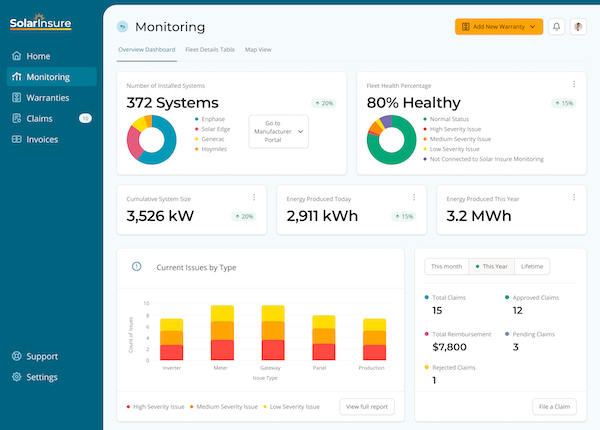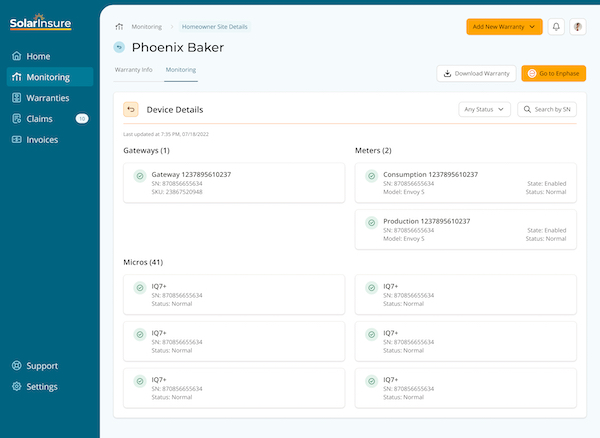The Future of Monitoring Software
Solar installers rely on system alerts for managing customer solar systems and repairs. Exceptional installers need a system that goes beyond many single manufacturer apps, one that helps streamline and improve business efficiency and after-install revenue. More intuitive monitoring systems are rolling out to ensure installers have the upper hand in management, able to tie repairs directly to an income stream. Most monitoring system interfaces are brand-focused and tailored to the end-user experience. While still somewhat helpful to the contractor, these one-off login platforms fail to deliver a seamless experience when managing thousands of accounts across multiple manufacturers. The outcome is that many contractors fail to use these systems because it’s too time-consuming to switch from one screen to another for basic information, then have to log in to each manufacturer's platform.

Future solar monitoring software will allow users to monitor multiple accounts across multiple apps all in one place, delivering an efficient bird's eye for prioritizing repairs. Monitoring software will become more functional and streamlined; certain features will be more automated, like processing claims, and getting paid out for homeowners that have warranties.
Future monitoring will feature added services, directly based on solar business needs, that will be able to perform some heavy lifting and save time. As a result, solar contractors will experience reduced administrative overhead, improved claim processing speeds, and the ability to continue building their reputation in the industry by supporting exceptional customer and after-install service.
What is contractor-centric solar monitoring?
 For contractors, high-level monitoring is a tool that allows your team to view multiple accounts from many manufacturers efficiently, all in one place. Pulling from each approved vendor platform to one central location, your team can effectively triage to prioritize repair and customer service needs. Future monitoring versions will improve claims processing automation, with reduced manual input and faster payouts.
For contractors, high-level monitoring is a tool that allows your team to view multiple accounts from many manufacturers efficiently, all in one place. Pulling from each approved vendor platform to one central location, your team can effectively triage to prioritize repair and customer service needs. Future monitoring versions will improve claims processing automation, with reduced manual input and faster payouts.
Benefits of installer-focused monitoring software:
Increased revenue
With installer-focused monitoring that is tied to customer warranties, contractors can have a financial structure connected to service work they may have previously performed for free, or had to charge to the homeowner, which created out-of-pocket fees to customers. Monitoring can increase revenue when tied to a warranty by allowing the contractor to file a claim without charging their customers. Repairs are made, customers are happy, and contractors are paid for their work.
Reduced downtime
When software is tailored to the contractor experience, homeowner repairs get resolved sooner. Reduced downtime will be attributed to an easier-to-use, centralized interface that allows contractors to see higher priority repairs, and schedule those claims faster. After-install repairs will be tended to more quickly, preventing homeowners from extended downtime. Homeowners will be spared from paying out of pocket for service work when tied to a warranty payout.
Grow your solar business
New monitoring software that puts solar business growth at the forefront will ultimately make homeowners happy, increase referrals, contribute to positive public opinion on solar, increase sales, and increase residential solar adoption.

New Features
A few new features will become more readily available to contractors, including a centralized analytic reporting dashboard to give installers data-driven insights on fleet health across multiple manufacturers. While currently available in some capacity, future monitoring systems will include automated email alerts and reports to help installers manage operations and maintenance on installed systems. Another feature to look out for is system-driven claim eligibility identification to make sure installers don't miss out on reimbursement opportunities. That will be tied into a streamlined claims filing process, with reduced data entry and faster payouts.
Why monitor?
Monitoring is a core feature for delivering the best after-installation service, and helping to boost confidence in residential and commercial solar energy. Installers can provide the best service through monitoring to stay on top of service calls and claims processing. Giving your customers the utmost peace of mind starts with monitoring. This includes a tied-in warranty so solar businesses can ensure they're taking the right actions at the right time, and are supported by a warranty for eligible claims payouts.
What is the cost?
You can source Monitoring Software and a 30-Year Warranty through your customer's original installation costs. The future of monitoring has no monthly fees, no out-of-pocket expenses; it’s just an added feature that helps contractors deliver the highest quality of service to customers. The best part about future-leaning monitoring software is that the contractor gets paid when a repair is required and a covered claim is generated, executed, and approved.
 What does monitoring do?
What does monitoring do?
Basic monitoring may involve losing time and money due to the effort spent hopping from one manufacturer portal to the next. New monitoring software is more business-focused, directly connecting system issues to claims, saving contractors time and increasing after-install repair revenue. In essence, monitoring should swiftly care for the repair needs of the homeowners while also promptly paying out the contractor.
New Monitoring Applications and their Business Benefit
Syncing and summarizing monitoring data saves time normally spent logging into each manufacturer's software to see system alerts. New applications will allow contractors to manage a fleet of systems across multiple inverter manufacturers, delivering digestible data from numerous inputs, making it faster to manage and use data for increasing after-install claims and revenue.
Software that's dedicated solely to contractors means that, instead of customers receiving alerts, the contractor receives them – so the contractor stays in control of service claim management and scheduling.
Having a Fleet Management System means you can easily log in to see precise and continuous component monitoring for registered systems (in the near future, this feature will include generated alerts). This allows contractors to quickly get a bird's eye view on systems that require repair, then dive deeper into more detailed needs for each system to triage and better prioritize service management.
Be on the lookout for new monitoring systems that are 100 percent dedicated to your solar interaction growth, tying revenue into a more generalized platform that helps you save time and make more money.
Dean Chiaravallotti is VP of Partnerships at Solar Insure, an independent monitoring and warranty company dedicated to providing clients with the highest quality professional risk management service.
Solar Insure | www.solarinsure.com
Author: Dean Chiaravallotti
Volume: 2022 November/December












